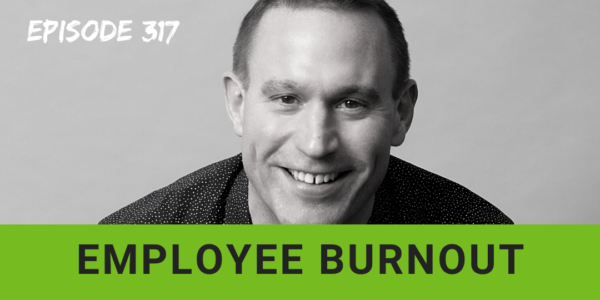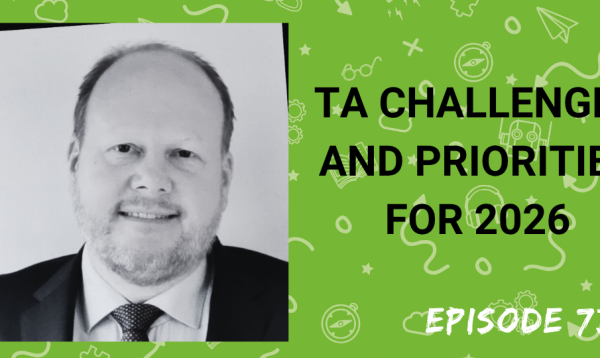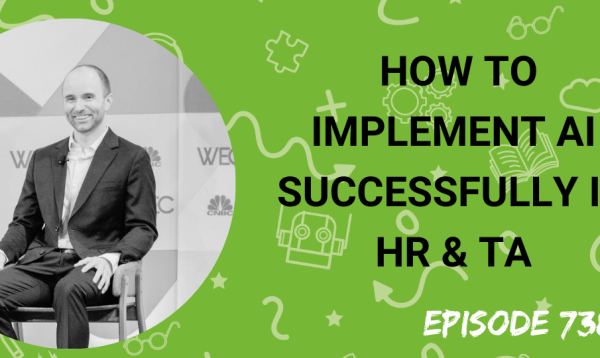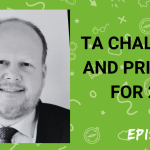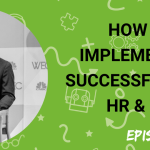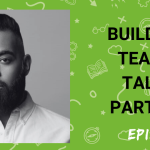To say that 2020 has been a tough year would be somewhat of an understatement. The health and economic challenges have put massive pressure on everyone and changed working life dramatically. Unsurprisingly some recent research from employee engagement specialists Glint reports a 33% rise in employees reporting burnout.
So what can employers do to deal with this burnout crisis and what support are employees asking for? To answer these questions and talk about their research, my guest this week is Steven Buck, Head of People Science at Glint.
In the interview, we discuss:
▪ What is employee burnout?
▪ The decline in connectedness and belonging
▪ What can employers do to help?
▪ No one size fits all solutions.
▪ Wellbeing and work/life balance
▪ Building habits around conversations fed by good data.
▪ What is the role of HR Technology?
Subscribe to this podcast in Apple Podcasts
Transcript:
Matt Alder [00:00:00]:
Support for this podcast comes from appcast, a leading provider of recruitment, advertising technology and managed services. AppCast helps more than 1500 companies find more qualified candidates using advanced programmatic technology and data driven analytics. With appcast, you’ll effortlessly attract the right talent to your open jobs, helping you save time and money. Find out more about Appcast at Appcast IO. That’s Appcast IO.
Matt Alder [00:00:51]:
Hi everyone, this is Matt Alder. Welcome to episode 317 of of the Recruiting Future podcast. To say that 2020 has been a tough year would be somewhat of an understatement. The health and economic challenges have put massive pressure on everyone and changed working life dramatically. Unsurprisingly, some recent research from employee engagement specialists Glint reports a 33% rise in employees reporting burnout. So what can employers do to deal with this burnout crisis? And what support are employees asking for to answer these questions and talk about their research? My guest this week is Steven Buck, head of people science at Glint. Hi, Steven, and welcome to the podcast.
Steven Buck [00:01:45]:
Thanks, Matt. It’s great to be here.
Matt Alder [00:01:46]:
An absolute pleasure to have you on the show. Could you just introduce yourself and tell everyone what you do?
Steven Buck [00:01:53]:
I’d be happy to. So my name is Steven Buck and I’m a principal cons for the people science team at Glint, responsible for a lot of the consulting in the European operations. I’m a psychologist. I’m a chartered occupational psychologist. A little bit of a mouthful, I know. And I’ve been doing this now for about 21, 22 years. By this I mean generally working on the consulting side of things. So consulting to some of the world’s largest organizations, really getting a feeling of what their employees are saying and putting data in, in a manageable format into the hands and their minds of the leadership team, hopefully with the idea of getting behavior change very much on the docket.
Matt Alder [00:02:38]:
Now, there will be some people listening who may not be familiar with Glint and the work that you do there. Can you tell us a little bit about what Glint is and what it does?
Steven Buck [00:02:49]:
Absolutely. So Glint essentially is a people success platform. And I’ll go into a little bit in more detail about what I mean by that. In the old days, if I can put it that way, we used to research engagement. Before that we talked about satisfaction and commitment. Glint really sits in the middle of a new wave of organizations which try to get the fine balance between consulting, heavy research, background, heavy advisory background and a really, very, very advanced technological platform. So as things have moved on, Glint has looked at the marketplace and said we need to occupy a where people get real time data about their people and their organization into the hands of managers and have a platform which tells them which levers they need to pull, where in the business they need to focus, and how to drive the right habits and conversations. So basically sitting in between the technology providers and the traditional consulting providers, that’s effectively what Glint does.
Matt Alder [00:03:55]:
Glint have recently published a report on something that, that’s incredibly relevant in this, in this sort of very stressful and difficult year, which is employee burnout. Now, I’m interested to sort of talk about the results and what you found and, you know, also some of the things that employers can do to fix this problem. But before we do, though, it’s probably worth just going through what you mean by employee burnout.
Steven Buck [00:04:19]:
Absolutely, Matt. Now, there are. I’m an academic at heart. I grew up through the psychology academia route. Very much now focused on the practitioner side of things. So there may be multiple definitions of burnout, which I’ll probably take from, or add to, or detract from. But effectively what we’re looking at when we talk about burnout is the data that’s being provided by employees themselves and in particular the comments that they’re writing in response to the surveys. So some of the things that we look at through the analysis that we’re doing are when people talk about topics like stress or burnout itself, or workload or anxiety or any of these types of cues, that effectively flags the signal to us that we have a comment where somebody is talking about what we classify as burnout. Since the beginning of the pandemic, we’ve been collecting data from a huge number of employees in our client database. We actually have 1.75 million employee engagement surveys now. And actually the data points within that is in excess of 7 million data points. When we did that and analyze the comments we’ve done so over time, we found that just over 5% of employees now are providing free text comments that spoke about those fatigue, being overwhelmed, and other potential signals of burnout. By contrast, in January, that was around 4% of respondents. So you can see that in a relatively short space of time. I know it doesn’t feel like it at the moment, but we’ve seen a real uptick in the number of employees that are registering those comments on burnout. Interestingly, by contrast, over the past two years, those levels have averaged just around the 4% mark. So overall, that’s an unprecedented 33% rate rise. So I’m sure you’ll have a lot more questions to ask about that. I started already talking about the statistics, but that’s how we’re effectively gathering those data.
Matt Alder [00:06:18]:
Very interesting stuff. And yeah, no, it would be good to find out more about those statistics. So I suppose, unsurprisingly, we’re seeing a big rise in burnout. What else did you find out and did you kind of identify the specific reasons behind it? I’m sure we can all hazard a good guess at the general trend, but some of the specifics, yes, absolutely.
Steven Buck [00:06:39]:
Well, we’ve got a pretty good idea. In essence, worldwide, people have been coping with a range of hardships this year. And we don’t need to speak about what’s happening at the moment in terms of the global pandemic conditions. Things that just simply haven’t been experienced by people in general for over a century, around a century. There are things that we’ve pinpointed that have led to this and we’ve been tracking them over time. Things like social isolation, things like enforced working from home, in some cases for employees that have never experienced such a working environment before. Things like school disruptions. And now, of course, looking at the in and out of furlough and increasing numbers of layoffs in many major economies. So those are some of the things that we’ve picked up on. But because the free text comments capture only part of that burnout experience at work, we know that the number of people that are feeling exhausted, ineffective and disconnected from their work may be considerably higher. So effectively, Matt, there’s two levels to this. We’re looking at the classic indicators of burnout and stress and distress. But there are also some much more subtle cues that we’re measuring. As I mentioned before, another cause for concern is the Glint data shows that employees sense of connection at work has significantly declined in recent months. And that’s actually been something that we’ve been monitoring right since the beginning of the pandemic. In the same way that we’ve been tracking burnout is how people feel connected to their organ at the beginning. So earlier in the year, people actually felt a real increase in the connection, despite the fact that the rug had been pulled from under their feet. They felt the sense of the increase in connection because they generally felt that their organizations responded very, very well to the early stages of the pandemic. But then I guess when the initial dust started to settle, that people started to adjust their new ways of working, sometimes very, very familiar to them, sometimes not familiar, familiar at all, doubled up with the situation of things like family and personal circumstances adding or just compounding those stress levels. We found that that sense of connection has been significantly eroded over recent months. So we know that some 37% of employees, for example, now feel less connected to their employees. Around a third feel less connected to their leaders. So companies with the least erosion in the sense of connectedness show markedly lower rates of burn. So we’re really, really interested in the connection between belonging and connection and those levels of burnout. There’s quite strong parallels there.
Matt Alder [00:09:15]:
Again, that’s really interesting in terms of the sort of the connections that you’re identifying there. I suppose my next question is really around what employers can do about this because it’s a pretty sort of depressing picture, as you say. We’ve been through a number of phases this year. There was an initial kind of shock phase and now we’re sort of very much into companies planning for the future, thinking about how their relationship with their employees works moving forward and really sort of trying to fix some of these, some of these problems. So what practical suggestions do you have for organizations or what are you seeing that that’s working to, to solve some of these issues and make things better for everyone?
Steven Buck [00:09:57]:
We’ve, we’ve got a number. I mean, the first, the first thing I would say before I get into some of the detail is that it’s really important that, that managers and organizations recognize that people are experiencing this situation very, very differently. So even employees that are effectively doing the same job and look the same on paper if you like, may have very different circumstances. There may be people who are living alone. There may be people who are fighting for shared space around a dining table every day. There may be people who are sharing space with a very, very large family or no family at all and disconnected from them. So the first thing is really just to understand that people are experiencing it differently. That’s going to help address the issues because the one size fits all model that you might apply for other organizational elements really doesn’t apply in this sense. So for example, I’ll give you an example. In July, we found that nearly three out of four employees between the ages of 24 and 38 expressed a high interest in much more employer sponsored mental health and wellbeing support. Around three out of four employees expressed a strong desire for more support for work life balance. Since then, we’ve seen managers really trying to get in touch with the learning elements that we’re offering here at Glint in Cooperation with our parent company, which is LinkedIn. And some of those things are around having access to more of a pastoral conversation with employees, asking them how they’re doing, asking them how they can support them. Things that many managers may have actively avoided in the past because it felt a little bit too much of a crossover between home and work life. But our recommendation overall is to start with one of the most straightforward but effective HR tactics in the book, Conversations. So just simply talking to people, I’m talking to a lot of leaders, I’m talking to a lot of HR managers and senior executives at the moment who are saying our managers are panicking because they don’t know how to address some of the concerns that are facing them. And actually, when I look at it, a lot of the skills that managers think they don’t have are simply around talking to people, asking them how they can help. And there’s no manager training course that you could go on for that. So they’re more dormant skills rather than skills that managers suddenly need to learn and embrace. So even better when it comes to conversations is recognizing that they need to have a much more personal cast this year. Addressing the needs of the person rather than focusing solely on what gets measured, gets done, that is the work goals. So we know that teams and organizations will have health concerns or childcare challenges, as I mentioned, that may be making it very difficult for them to focus. So helping in those conversations, helping employees prioritise, helping them understand what’s important today, even if that might be very, very different from what they were told last year or as they were developing their last performance review and plan for the year. So when managers are scheduling those structured check ins with team members and they’re doing so over zoom and it may feel slightly artificial, it’s really important that we can get that sort of sense of, that sense of connection, as I mentioned before, that personal touch. And we know that when we talk with people like Joss Burson, a global HR thought leader, he talks about this idea of a check in. Not being about micromanaging your team, but about building relationships by being aware of what’s going on for the individual. Again, one size does not fit all. So critically, building habits around conversations is that are fed by good data. You need to ask your employees how they’re feeling either in person or through some kind of regular exercise, like a Glint survey. When you do those regular conversations, employees are telling us that they’re able to better do their work, they’re able to take care of themselves better, and we simply cannot afford to run the risk of employee burnout at the moment, both for the duty of care we have for our employees and also the impact it’s going to have on the internal and external outlook. So my recommendation, first and foremost, is start those conversations today to help address this critical workplace HR issue.
Matt Alder [00:14:11]:
Just to dig a little bit deeper into something that you just said there. So, obviously this is very individual, very human. It’s all about those kind of very human connections that managers are making. What role does technology like Glint take in this kind of process? You sort of mentioned engagement and conversations. Could you just give us a bit more detail about that?
Steven Buck [00:14:33]:
Yeah, of course. And somewhat controversially, you don’t need a survey to find out how your employees think. But as many organizations are finding, having those in person conversations en masse are very, very difficult because managers themselves have a lot to do. They have an increasing workload. They’re battling their own battles, if you like. So the majority of organizations we find, do send out some kind of employee survey, some kind of listening exercise with a company like Glint to help feed into the conversations I mentioned mentioned before. So it’s a much more efficient way. It’s a much more secure and confidential way of getting feedback on some things which may be incredibly personal. So in the early stages, we know that employees felt probably a little bit worried about having those straightforward conversations with their manager. As we saw job losses on the horizon, people became a little bit more reluctant to say what they really felt. So having those confidential vehicles to share opinions is essential. So we know that the engagement survey process also contributes to employees feeling involved. When we started doing these, the early pandemic surveys, we were asking people questions like, how are you doing? And the feedback we got from employees was remarkable. First of all, they were amazed their employees hadn’t stopped listening. They were expecting to hear the usual things like, well, we’ll get a negative response, so we’ll stop asking. To which we would say, would you stop asking your customers how they feel in difficult times? Of course, the need is still there to find out what people are thinking. So our advice right now is that if you have a scheduled survey upcoming, especially in these challenging and rapidly changing times, we’d recommend monthly at the moment. And that feels like a heavy lift for many organizations. But actually, when you get into the habit of listening, it’s a much lighter lift than you might expect. And critical to that, of course, is having shorter, more technologically advanced surveys where it takes people a matter of minutes to respond, rather than waiting for 120 questions to come round every two years and feeling quite fatigued with the survey process itself. So we know that we need to revisit the content as well using that vehicle. As I mentioned, we can swap things out. We can be flexible and agile around the content. So organizations might be asking about well being now at the early stages they may have been asking about equipment and processes to get things done when people were initially working from home. So we can rapidly switch out the content as things become an issue for organizations. And I mentioned before that whilst employees are not one size fits all, organizations aren’t either. In many cases, global organizations where the pandemic and the situation is being experienced at very, very different stages. So knowing how to address those within the organization in different regions and countries and jurisdictions that may be very different again, give us a reason to have something which is agile and can be deployed at a moment’s notice. So if you don’t have something happening, consider adding a survey in to check in with your people on all the topics we’ve mentioned before and other topics that might be arising.
Matt Alder [00:17:44]:
Steven, thank you very much for talking to me.
Steven Buck [00:17:47]:
It’s my pleasure. Thank you very much for having me.
Matt Alder [00:17:50]:
My thanks to Steven Buck. You can subscribe to this podcast in Apple Podcasts on Spotify or via your podcasting app of choice. Please also follow the show on Instagram. You can find us by searching for Recruiting Future. You can search through all the past episodes@recruitingfuture.com on that site. You can also subscribe to the mailing list to get the inside track about everything that’s coming up on the show. Thanks very much for listening. I’ll be back next time and I hope you’ll join me.

